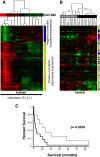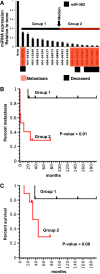MicroRNAs at the human 14q32 locus have prognostic significance in osteosarcoma
- PMID: 23311495
- PMCID: PMC3566973
- DOI: 10.1186/1750-1172-8-7
MicroRNAs at the human 14q32 locus have prognostic significance in osteosarcoma
Abstract
Background: Deregulation of microRNA (miRNA) transcript levels has been observed in many types of tumors including osteosarcoma. Molecular pathways regulated by differentially expressed miRNAs may contribute to the heterogeneous tumor behaviors observed in naturally occurring cancers. Thus, tumor-associated miRNA expression may provide informative biomarkers for disease outcome and metastatic potential in osteosarcoma patients. We showed previously that clusters of miRNAs at the 14q32 locus are downregulated in human osteosarcoma.
Methods: Human and canine osteosarcoma patient's samples with clinical follow-up data were used in this study. We used bioinformatics and comparative genomics approaches to identify miRNA based prognostic biomarkers in osteosarcoma. Kaplan-Meier survival curves and Whitney Mann U tests were conducted for validating the statistical significance.
Results: Here we show that an inverse correlation exists between aggressive tumor behavior (increased metastatic potential and accelerated time to death) and the residual expression of 14q32 miRNAs (using miR-382 as a representative of 14q32 miRNAs) in a series of clinically annotated samples from human osteosarcoma patients. We also show a comparable decrease in expression of orthologous 14q32 miRNAs in canine osteosarcoma samples, with conservation of the inverse correlation between aggressive behavior and expression of orthologous miRNA miR-134 and miR-544.
Conclusions: We conclude that downregulation of 14q32 miRNA expression is an evolutionarily conserved mechanism that contributes to the biological behavior of osteosarcoma, and that quantification of representative transcripts from this family, such as miR-382, miR-134, and miR-544, provide prognostic and predictive markers that can assist in the management of patients with this disease.
Figures




References
-
- Khanna C, Lindblad-Toh K, Vail D, London C, Bergman P, Barber L, Breen M, Kitchell B, McNeil E, Modiano JF. et al.The dog as a cancer model. Nature Biotech. 2006;24(9):1065–1066. - PubMed
Publication types
MeSH terms
Substances
Grants and funding
LinkOut - more resources
Full Text Sources
Other Literature Sources
Medical
Research Materials

